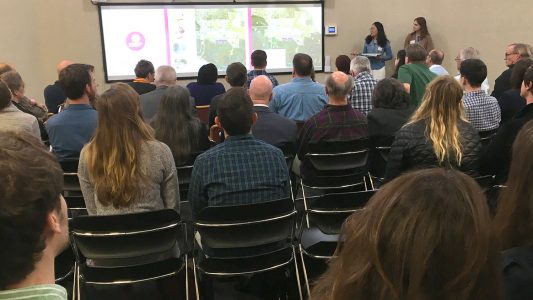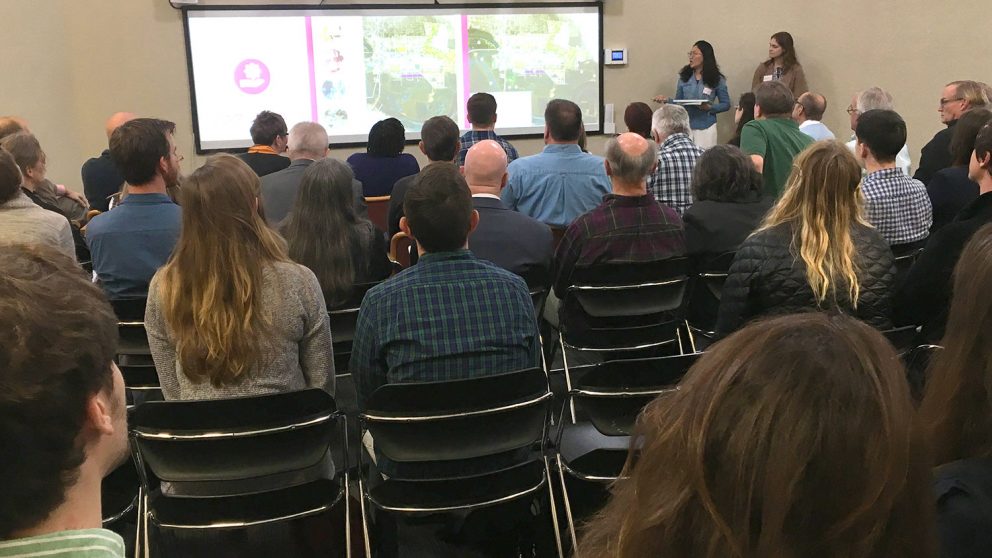
Floyd. Matthew. What major storm will impact eastern North Carolina next?
Amid the destructive aftermath of Hurricane Matthew last fall, NC State’s College of Design saw an opportunity to help N.C. communities devastated by widespread flooding. In mid-January, the college hosted its inaugural DesignWeek for students to develop designs that could help three rural communities adapt to a changing climate and the realities of flooding.
About 70 students — including 15 architecture students, all landscape architecture students and 15 students from UNC Chapel Hill’s Department of City and Regional Planning — worked in 12 teams assigned to one of three eastern N.C. communities: Windsor, Greenville or Kinston. With guidance from faculty, industry mentors and community leaders, students researched and created designs to mitigate future flood damage in these areas.
“We see [DesignWeek] as a beginning — a catalyst to bring folks together and to get collaboration and discussion going,” said landscape architecture associate professor Andy Fox.
Hurricane Matthew created $1.5 billion in damage to tens of thousands of homes, businesses and public facilities. The storm caused record-setting highs for many waterways, including the Neuse River that runs through the city of Kinston.
There, student teams proposed a downtown Kinston streetscape that is bikeable, walkable and designed to reduce stormwater impacts. More affordable housing would increase density of downtown and strategically elevated streets could reduce future flooding.
Because much of the especially flood-prone area will be subject to government buyouts, the students suggested restoring these areas to wetlands that would improve water quality and wildlife habitat. Additional levees could block future floodwater, rain gardens could control stormwater and specific plants could help remediate the soil.
In the Adkins Branch area, students proposed a memorial forest to honor long-time residents displaced through buyouts.
“This would recognize the families that once lived here and the sacrifice they made to restore the wetlands,” said landscape architecture student Virginia Fall.
About 80 miles northeast of Kinston, the community of Windsor is all too familiar with flooding. Heavy rain from Tropical Storm Julia flooded the community just weeks before Hurricane Matthew caused more major flooding. Located along the Cashie River, the rural community is just 3 feet above sea level.
“We can’t stop all floods, we have to work with them,” said landscape architecture student Anna Grace FitzGerald.
Students suggested creating intentionally “leaky” river dams to slow the water’s direct impact on Windsor. For water that does reach the city, the students advised stormwater management such as bioswales and a small flood wall.
“It’s a very complicated issue. You can’t solve it with one strategy,” said landscape architecture student Jaquasha Colon.
In Belvoir, a rural community northwest of Greenville, one student team proposed a new funding strategy known as community-scale assisted migration (CSAM). This proposed strategy could help relocate residents out of floodplains and to higher ground within their own communities.
Flood-prone areas that became public land through government buyouts could be converted to greenways that would “change the attitude from river as destroyer to river as amenity,” said landscape architecture student Adam Walters.
Residents impacted by buyouts would have the option of moving to a new development within the community, where temporary housing would be provided in small houses instead of travel trailers. Over time, residents could choose to purchase a lot and build a larger house.
“This [concept] is exportable and scalable. It would work all over the country,” Walters said. “Belvoir is a good place to start because the demographics typify a rural, flood-prone community.”
That widening of the lens beyond these three counties is foundational to the DesignWeek experience, according to Gene Bressler, who leads the college’s landscape architecture department.
“Flooding happens all over the world. It’s not just North Carolina,” he said. “The lessons that the students learn, they can take on with them.”
As for the dozens of ideas suggested by this year’s DesignWeek student teams, the college’s faculty and community partners have the opportunity to begin applying the students’ suggestions.
“We will carefully assess which aspects of these projects can start something so that this isn’t just an academic exercise,” Fox said.
